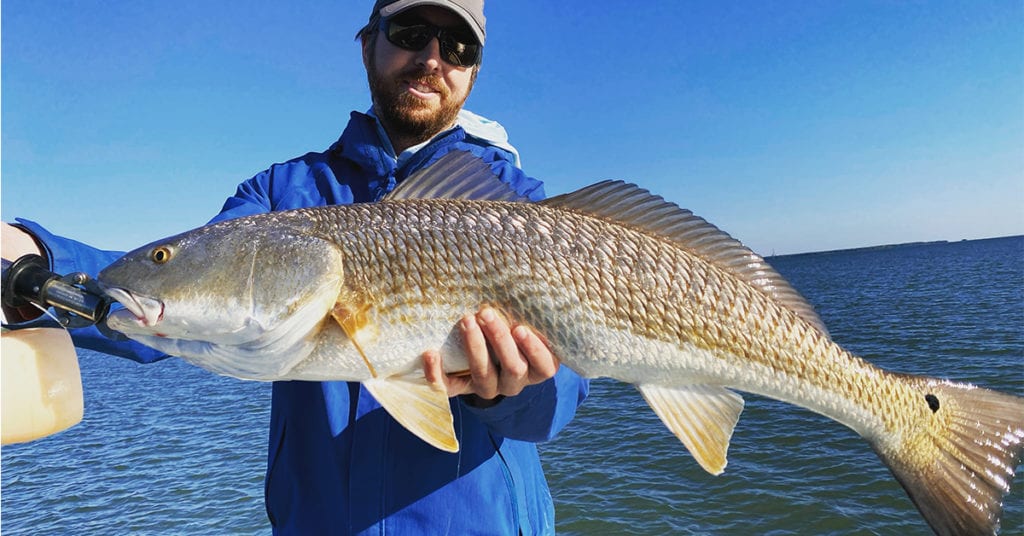Does Mono Actually Float? (Fluorocarbon vs. Monofilament Contest)
- By: Luke Simonds
- on

Does mono float or sink?
What about fluorocarbon line?
Does it sink or float?
There’s a lot of misunderstanding in the fishing industry regarding this question, so I decided to do a side-by-side comparison of how fast monofilament sinks (if it does at all) compared to fluorocarbon.
I compared how they do in saltwater and tried several different diameters of fishing line so that my results could be as accurate as possible.
Want to see the results?
Check our newest experiment below.
Fluoro vs. Mono Sink Test [VIDEO]


Here are the results of the test:
30 lb Monofilament (Ande): Sink rate of 5.0 seconds
30 lb Fluorocarbon (Vanish): Sink rate of 2.1 seconds
20 lb Monofilament (Berkley): Sink rate of 5.5 seconds
60 lb Fluorocarbon (Seaguar): Sink rate of 1.3 seconds
Here’s what we learned from this experiment:
- Monofilament does not float
- The diameter of the material matters (thicker line sinks quicker)
- Fluorocarbon sinks ~2.5x faster than monofilament. This matters more if you’re using one of these as a main line, but probably not as much if you’re using one of them for just leader material with braided line for your main line.
Conclusion

Contrary to popular belief, monofilament actually does sink, although it sinks a little slower than fluorocarbon.
Have you found anything different than the results I got?
Let me know in the comments below!
For more experiments like this, you can see all of our fishing line tests here.
And if you know someone who thinks mono floats, please TAG or SHARE this with them!
P.S. Want access to our best fishing spots and tips, plus discounts to our online tackle store? Click here to join us in the Insider Club.
Stop Wasting Time On The Water!
Do what the “SMART ANGLERS” are doing and join the Insider Club.
Here’s what you’ll receive today when you join:
- Weekly fishing reports and TRENDS revealing exactly where you should fish ever trip
- Weekly “spot dissection” videos that walk you through all the best spots in your area
- Exclusive fishing tips from the PROS you can’t find anywhere else
- Everything you need to start catching fish more consistently (regardless if you fish out of a boat, kayak, or land).
Click here to join today.
Related articles:
Related categories:
STOP WASTING TIME ON THE WATER!
Do what the “SMART ANGLERS” are doing and join the Insider Club.
Here’s what you’ll receive today when you join:
- Weekly fishing reports and TRENDS revealing exactly where you should fish every trip
- Weekly “spot dissection” videos that walk you through all the best spots in your area
- Exclusive fishing tips from the PROS you can’t find anywhere else
- Everything you need to start catching fish more consistently (regardless if you fish out of a boat, kayak, or land).










Do a stretch test next. My experience has been that most fluorocarbon lines stretch just as much as mono.
Here’s an interesting test that I think you’ll appreciate… it’s a stress test to measure how much fluoro and mono lines degrade after getting tension applied to them: https://www.saltstrong.com/articles/fluoro-vs-mono-line-stress-test-experiment/
Perfect test!
Thanks!
What braided line sinks?
I fished side by side. Me using mono leader. My partner using floro. He consistently caught more snook. I caught trout. After a year I switched to floro. Immeditly I started catching snook. That’s topwater lures. Free lining shrimp swivels no swivels ect. Snook see mono better. Also I use 6′ leader . He used 4′.
Flouro more abrasive resistant? Not in my experience. Great article
Their marketing says it is, but all tests I’ve done with mono vs. fluoro on abrasion has the less expensive mono performing best. Here’s one in case interested: https://www.saltstrong.com/fishing-tip/fluorocarbon-leader-abrasion-test-vs-mono/
Ipso Facto.
Thanks dood! Love these tests you do!
Thanks for making time to leave the nice comment!
Thanks Luke, appreciate the efforts to save us money.
My pleasure Jeffrey! Thanks for making time to leave the nice comment.
Thanks Luke
My pleasure Jerry! Thanks for making time to leave the nice comment.
With all due respect, your test is a bit misleading. I’ve got over 20 years fly fishing, mostly freshwater, and believe your premise for the discussion is off. Yes, Mono sinks. Issue is Mono floats much better on the surface of water than does fluorocarbon. The composition allows it to float better. The relative diameter of mono is greater. Having spent 20 years regularly using both, the way to go is if you want your leader on the surface, use Mono. Ginking up mono helps with the floatation as well. Subsurface, use fluoro if you are concerned about abrasion. I nearly always use fluorocarbon at the end of my leader because the diameter is less and it is more abrasion resistant. Believe you did a test on abrasion resistance between the two and I’ll tell you there absolutely is a difference between the two.
I completely agree with you that surface tension aspect is very important in fly fishing (especially dry flies where the line is not moving and needs to be at the surface). The reason why I didn’t test that aspect is because there’s currently only a very small segment of our audience who fly fishes with dry flies.
Plus, the fact that fluoro floats too when slowly placed on the surface of the water makes it very difficult to measure the difference in how much movement each line needs in order to finally break the surface and sink. But as you said, mono is definitely the way to go for anyone who wants to keep the leader line at/near the surface because it surely has an advantage in the surface tension aspect as well as its definite advantage is the sink rate once the surface tension is broken.
As for your comment about fluorocarbon being more abrasion resistant than mono, could you please let me know what you’ve done to come to that conclusion. I have done multiple tests on that aspect, and each one has shockingly gone towards the favor of traditional mono (even when equating their diameters). Here’s a link to one of the tests that totally shocked me: https://www.saltstrong.com/fishing-tip/fluorocarbon-leader-abrasion-test-vs-mono/
Luke, appreciate the response. Agree that float-ability is mainly important in the fly fishing world. Applies for dry flies as well as when indicators are used. Often times, you can use an indicator and suspend a fly below. Example in salt could be something like a shrimp pattern. Mono will absorb water, which is why most folks will gink up the leader to help it float after a bit of use. My conclusion on fluoro being more abrasion resistant is based on experience. Have fished many areas where mono would get chewed up by bottom structure such as rock, where the fluoro would show minimal wear. Nothing scientific to it, just what has worked. I’m all for using something that’s cheaper if it works, but where there’s a chance of abrasion, I’ll stick with the fluoro at the terminal end personally. I’ve seen the video you did. Just not sure the test is accurate for realistic conditions. Love all the work you all are doing, I’m just in a bit of disagreement when it comes to your presentation of mono vs fluoro.
Thanks for letting me know. Do you have any ideas on how I can make that mono vs. fluoro test more accurate? I repeated it using lines that were soaked under the water for a couple hours, and the results were the same (mono won… and I didn’t see any noticeable difference between how the pre-soaked line did vs. the non-soaked lines)
I’m totally unbiased in the mono vs. fluoro feud, so I’m always looking for ways to make these experiments as accurate as possible so that we all can make informed decisions on which ones we should be buying.
Luke love the videos, could you also try the high floating mono such as the sunline FF2?
Designed to float better
Why floro vs mono for leader?
Most fishermen (including me for many years) believe the fluorocarbon is better for (1) being invisible underwater, (2) having stronger knots, and (3) being more abrasion-resistant. This is surely due to the huge amount of marketing dollars that have flooded the market (tv shows, magazines, etc.) on how great this new line is.
But my eyes have been opened lately after actually testing them against one another… so far, the knot breaking tests have had traditional mono coming out as the winner, and all of the abrasion strength experiments have favored the less expensive traditional mono too (here’s one that was very conclusive: https://www.saltstrong.com/fishing-tip/fluorocarbon-leader-abrasion-test-vs-mono/).
The final aspect to test will be the visibility factor, and I’m in the process of putting together an accurate way to analyze it. But this simple video above at least proves that fluoro is not invisible underwater given that it is easily seen as it was sinking.